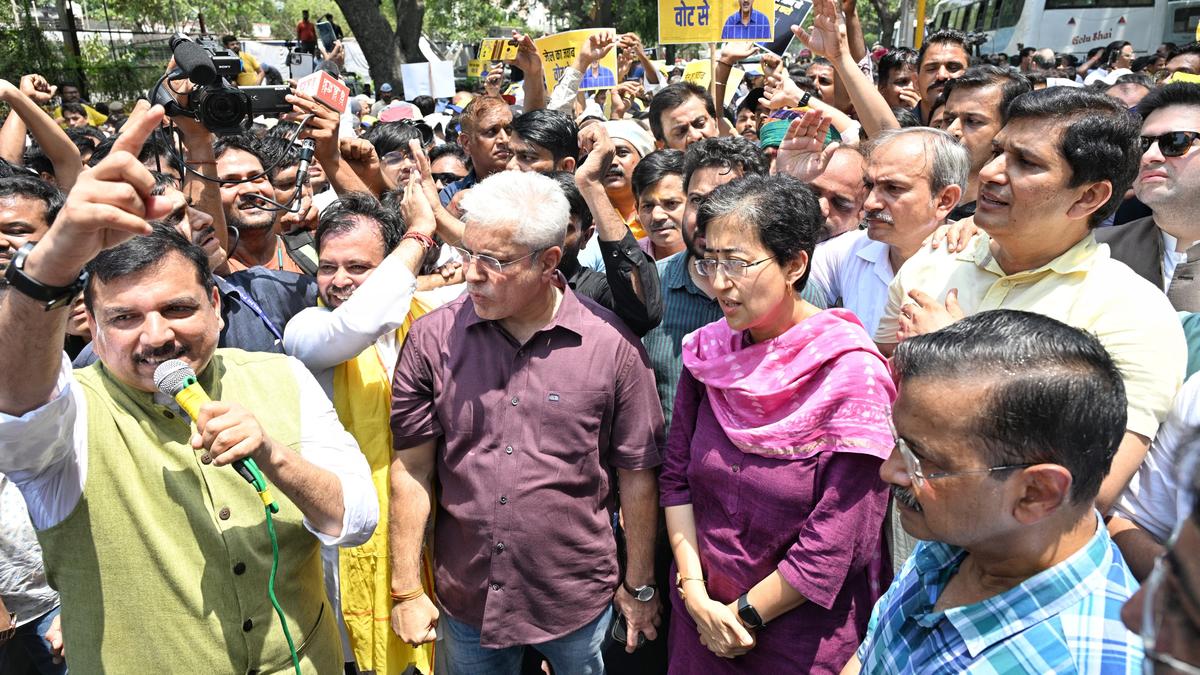Ln its last full year budget ahead of general elections, the government aimed at pushing growth through higher capital spending while continuing on the path towards fiscal prudence. The government targeted a fiscal deficit of 5.9 percent of GDP as compared with 6.4 percent in the previous year, keeping in view the medium-term goal of achieving the fiscal deficit at 4.5 percent of GDP by 2025-26.
A look at the government’s finances for the first half of the year suggests that the government is largely on track to achieve its fiscal consolidation roadmap. However, there could be some pressure on revenues and additional spending that could lead to slippage from the budgeted targets.
Possibility of deviation from the revenue expenditure target
To reaffirm its commitment to fiscal consolidation, the government proposed only a modest 1.4 percent increase in revenue expenditure for the current financial year.
In the April-October period, the Union Government’s revenue expenditure increased by 6.5 percent over the same period last year. The Government has already spent 52.7 percent of its budgeted target for the full year. The adherence to the full year target would therefore require a contraction in revenue expenditure in the remaining months of the current year.
This seems an unlikely possibility in an election season.
The extension of the free food grain scheme for five years and the enhanced allocation on MNREGA could exert pressure on the Government’s finances. To be fair, the impact of the extension of the free food grain scheme will have only a limited impact on this year’s fiscal performance. The impact will be seen in the coming years.
The Government has announced a sharp increase in minimum support price (MSP) for the Rabi crops in 2023-24. The MSP on wheat has been increased by Rs 150 per quintal to incentivise farmers to cultivate wheat amid worrying prospects of a weaker wheat output due to lower soil moisture and strengthening of the El Nino. The decision, which has both political and economic fallout, could lead to an uptick in food subsidy allocation for the current year.
The government has sought approval of Parliament for an additional spending of Rs 58,000 crore towards allocating more funds for MNREGA, fertiliser and food subsidy. This is the first batch of supplementary demand for grants for this financial year.
While the next cash outgo is sharply lower than the cash outgo through the first supplementary demand for grants of last year, the implication of additional demand for funds on the fiscal consolidation plan would need to be monitored in the remaining months of the year.
Challenges on the receipts front
Total receipts of the central government stood at Rs 15.9 lakh crore, accounting for 58.6 percent of the budget target. Last year, by this time, the government had achieved 60.7 percent of its budgeted target. The slowdown is attributed to weakness in tax revenues. Net tax revenues in April-October were 55.9 percent of the budgeted targets. In the corresponding period of last year, net tax revenues accounted for 60.5 percent of the budgeted target.
 Graphic by Soham Sen, ThePrint
Graphic by Soham Sen, ThePrint
Most of the taxes barring income taxes reported a lower growth in April-October of 2023-24 as compared to the corresponding period of last year. As a percentage of the budgeted targets also, these taxes have under-performed in the first seven months of this financial year as compared to last year.
 Graphic by Soham Sen, ThePrint
Graphic by Soham Sen, ThePrint Graphic by Soham Sen, ThePrint
Graphic by Soham Sen, ThePrintIn October, collections from major taxes, barring income tax and GST reported a contraction. Corporation tax declined by more than 13 percent, customs duty by more than half and excise tax contracted by 1.2 percent.
Additionally, the government’s non-debt creating capital receipts have seen a slow pick-up. Out of Rs 51,000 crore expected to be achieved in this year, the receipts from disinvestments have been only Rs 8,000 crore. Some of the key disinvestment plans — NMDC Steel, Hindustan Zinc and IDBI Bank — are unlikely to materialise this year. This would mean that the government would have to substantially scale down its estimate of disinvestment receipts for the current year.
Further Rs 10,000 crore was expected to come from monetisation of government assets in the coming year. There has been no progress on this front.
Encouragingly, however, the impressive non-tax revenue collections could offset the shortfall on account of disinvestment receipts. The buoyancy in non-tax revenues is on account of healthy dividends from RBI and state-owned banks. The government has already achieved more than 88 percent of its budgeted non-tax revenues in the first seven months of the current year.
Moderation in nominal GDP growth could upset fiscal math
India’s nominal GDP growth was pegged at 10.5 percent for the current year. In the first half of the current year, nominal GDP grew by 8.6 percent. Nominal GDP growth is the benchmark to estimate tax collections and projections about various deficit indicators. If the nominal GDP grows less than expected, the fiscal deficit, in absolute terms, would have to shrink to maintain the targeted fiscal deficit as a percentage of GDP at 5.9 percent.
Higher nominal GDP helps in lowering fiscal and debt ratios but this support may not be available this year as global commodity prices continue to trend downwards. Despite production cuts announced by OPEC +, global demand concerns could keep global oil prices subdued.
Global food and metal price rise is also muted and the trend is unlikely to see a major reversal in the remaining months of the year. Reflecting the moderation in global commodity prices, WPI inflation remained in the deflation zone for the seventh month in October.
Capital expenditure continues its growth momentum but could be scaled down
The government has maintained its focus on capex with capital expenditure registering a growth of more than 33 percent in April-October of 2023-24. Almost 55 percent of the budgeted target has been spent in the first seven months. If there is pressure on receipts in the coming months, and additional funds are sought, there is a possibility that capital expenditure could be scaled down to stick to the 5.9 percent fiscal deficit target. This could be challenging on the growth front.
 Graphic by Soham Sen, ThePrint
Graphic by Soham Sen, ThePrint Graphic by Soham Sen, ThePrint
Graphic by Soham Sen, ThePrintOverall, the government seems broadly on its path of fiscal consolidation but some challenges could lead to compression of capital expenditure or minor deviation from the deficit target. The cushion provided by taxes would be crucial in the coming months.
Radhika Pandey is associate professor and Rachna Sharma is Fellow at the National Institute of Public Finance and Policy.
Views are personal.
Also read: After causing some worry, manufacturing brings a pleasant surprise in Q2. But consumption a concern

 5 months ago
79
5 months ago
79



